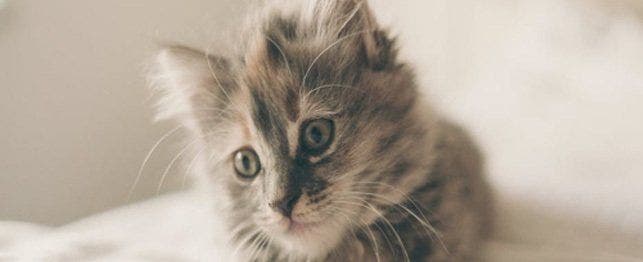
When Will Your Cat Stop Growing?
Kittens are like cute, fluffy, weeds; they just keep growing! In fact, your kitten will grow so fast that you’ll find yourself wondering when on earth it will stop. PetPlace is here to help you understand your cat’s growth periods. As your kitten matures into a fully grown cat, there will be many exciting milestones to mark the journey, not to mention, as your kitten grows into a cat your bond will only grow. Each breed and individual cat can be smaller or larger than average based on their diet and early life. The weights and milestones listed below should function more as guidelines as opposed to set in stone facts.
Week One
Approximate Weight: 3-5 ounces
The first six weeks of a kitten’s life is when the most rapid rate of growth takes place. At birth, a newborn kitten only weighs a few ounces, and its eye and ear canals have not yet opened. Newborn kittens are not able to move much, but these little fuzzy jellybeans can make quite the racket while searching for their mom’s milk. If you’ve ever had the privilege of sitting next to a box full or newborn kittens, then you’ve heard their small cries as they hunt for dinner. At this stage of development, kittens don’t even have teeth, and they spend the majority of their days sleeping.
The mother cat is incredibly important during the first few weeks of a kitten’s life. In the first 48 hours, the mama cat will deliver much need colostrum to the kittens. The Colostrum is nature’s vaccine – this power combination of maternal antibodies, large protein antibody molecules, water, vitamins, electrolytes, and nutrients is everything a growing kitten needs to be safe and healthy. The properties found in a mother cat’s Colostrum will typically keep kittens healthy until it is time to get their first round of vaccinations.
In the first week of a kitten’s life, a kitten is liable to double its weight. Studies have shown that kittens who are handled 15-40 minutes a day during their first seven weeks of life are more likely to develop larger brains. Not that you need an excuse to play with kittens, but if anyone ever asked you could say that you are snuggling with baby cats to improve their intelligence.
Weeks Two and Three
Approximate weight at the end of week three: 7 ½ – 14 ½ ounces
Kittens will become a little more aware of their surroundings in this stage. They will begin to jostle for their favorite spot and suppertime, and their eyes will start to open. By the end of the second week a kitten’s eyes should be completely open, but just because a kitten’s eyes are open doesn’t mean that it can see very much. At this stage of the game, kittens may begin exploring the concepts of walking – to mixed results. Week three a kitten’s teeth will start to come in meaning that the kitten is well on it’s way to starting solid food.
Weeks Four Through Six
Approximate weight at the end of week six: 16-24 ounces
During weeks four through six, you can expect to see another huge growth spurt. During the fourth week, kitten’s will somewhat master the fine art of walking and will begin to sort of jump and play between their cat naps and feeding. Here is when a kitten’s personality really begins to show. Additionally, by the end of week four, the ear canals have opened, and the kitten’s vision has cleared. It is during the fourth week of life that our veterinarians recommend you begin the weaning process with wet food as well as litter box training.
Week five is when your beautiful little bundle of joy becomes a Tasmanian devil. With developing motor skills and abundant energy, kittens will commonly be found zipping around while frequently running into stationary objects and each other. The huge growth spurts have ended, and now a more gradual growing process shall begin that will continue for many months. It is during this period of play that kittens will learn social structure and manners, this is a crucial step in the development of kittens. Kittens who are taken away from their mother and littermates too early can suffer from insufficient socialization – leading to numerous behavior issues down the road.
Weeks Seven Through Month Three
Approximate weight at the end of month three: 35-36 ounces
Some believe that at eight weeks of age a kitten is ready to be placed in its forever home, others believe that 12 weeks of age is the correct time to separate the kittens from their mothers. Each option has its advantages and disadvantages; it is up to the breeder or caretaker to determine which is best.
In the span between week seven and month three kittens can be spayed or neutered and should have completed their deworming and first set of booster shots.
Month Four and On
After the ninth week of life, the growth of a cat is much more gradual. From this point on a cat’s weight and growth will be determined by its breed and sex. So as to the questions of “when will my cat stop growing” the answer is…it depends. Unfortunately, there is no magic age for when a cat will be done growing, even littermates can end up being different sizes and can grow at different rates. In general, it can be said that most cats reach their full-grown size between 9-12 months of age. Larger cat species like Maine Coons and Ragdolls can keep growing at a slow and steady rate until the reach an age between 2-4 years old. The best way to determine when your cat will stop growing is to determine what breed your cat is. If you cat’s breed is not easily identifiable your vet may be able to help you out.